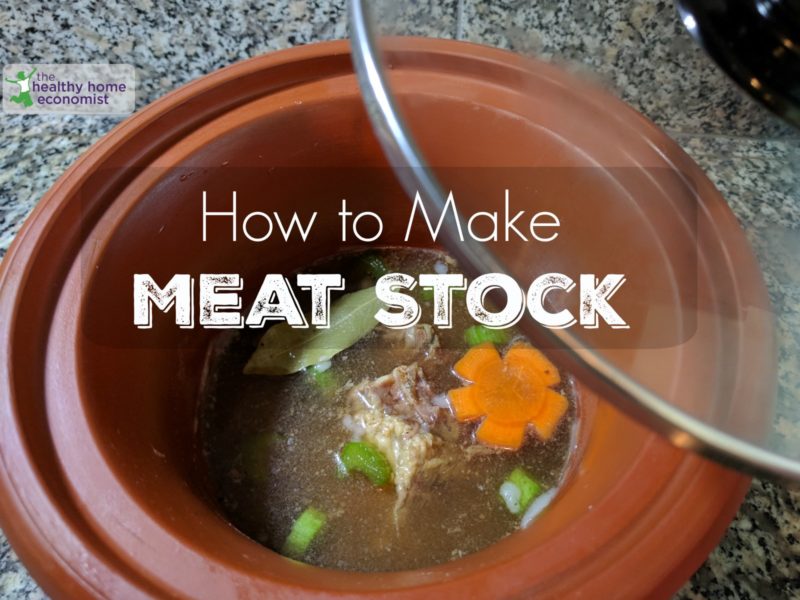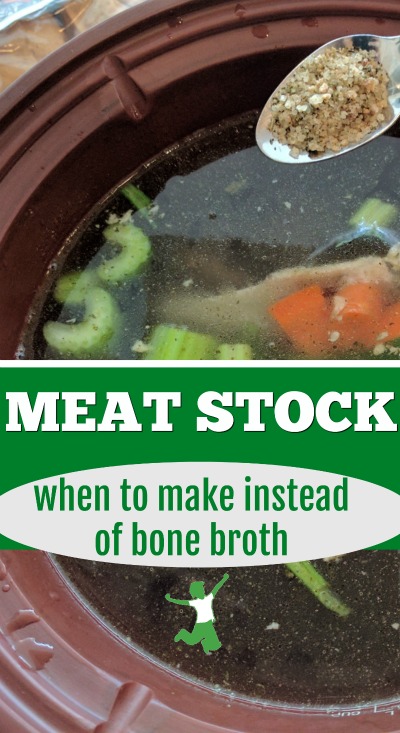How to make short-cooked meat stock for resolving autoimmune disease and improving gastrointestinal function if you cannot tolerate the glutamate in long-cooked bone broths.

Properly prepared homemade broth is a foundational food for autoimmune healing diets such as GAPS, AIP, or the Specific Carbohydrate diet.
The GAPS protocol, for example, recommends a small cup of broth with every meal. This traditional food is the only cooked food that acts as a raw food when consumed. This is accomplished by the gelatin in the broth, which powerfully attracts digestive juices to itself. This, in turn, significantly enhances the nutrient absorption for all the other foods consumed with it.
Ironically, this most curative of foods is frequently not well tolerated by people with leaky gut – the very people who desperately need it! Fortunately, this intolerance only lasts a short period of time until gut-healing advances.
What to do in the interim since bone broth is such an important healing food? The answer is to make meat stock instead.
When Meat Stock is the Better Choice
The reason some individuals with leaky gut do not tolerate bone broth is is due to the beneficial natural glutamates that can sometimes trigger uncomfortable reactions. MSG is the synthetic, factory-produced version of glutamate. MSG is an excitotoxin, which means it damages or even kills neurons. Neurosurgeon Dr. Russell Blaylock MD lays out all the science in his eye-opening book Excitotoxins: The Taste that Kills.
While the natural glutamate in bone broth are not dangerous or equivalent in any way to concentrated, factory-produced MSG, they can nonetheless trigger similar symptoms in sensitive individuals. Yeast extract can do the same. Thus, anyone sensitive to MSG typically does much better with meat stock, which has little glutamate by comparison.
Others best served by stock instead of broth are children and adults who are autistic, those with ADD/ADHD, and/or people suffering from seizures or tics.
Another sign that bone broth is best replaced with meat stock is when uncomfortable die-off symptoms, as well as nervous system agitation occurs. These are signs that your digestive tract is not ready for bone broth. Use meat stock when symptoms such as diarrhea, vomiting, nausea, constipation, and skin eruptions or rashes develop. Making the transition gradually from stock to broth is advisable.
Storing Meat Stock
When you make meat stock as described in the recipe below, you will notice that a significant amount of fat forms with it. This fat is best left in the stock. When it cools, it will rise to the top and remain there. The fat forms a protective seal that prevents oxidation.
Refrigerated meat stock will last a week or more with that layer of fat on top. If you prefer to remove the fat to create a clarified meat stock, it is best to freeze it. No worries, as meat stock thaws beautifully.
This article on freezing stock or broth provides tips on the safe use of either plastic or glass for this purpose.
Homemade Meat Stock
The most significant difference between meat stock and bone broth is that stock is not cooked as long as broth. This results in some pros as well as cons.
Pros
First for the pros. Stock is just as rich in gelatin and beneficial detoxifying amino acids (like proline and glycine) as broth. These nutrients are pulled out of the meat and connective tissue during the first several hours of cooking. A lengthy simmer is not necessary.
Another pro is that the meat used to make stock doesn’t become tasteless as it does with a long-simmering broth. It is delicious and can be used alone or with any meat dish you wish.
Cons
Now for the cons. First, you will notice that stock is not quite as flavorful as long-simmering bone broth. This is due to the significant reduction in glutamate.
The savvy home chef can compensate by ensuring quality vegetables are simmered with the meat stock. While making bone broth doesn’t always require vegetables to achieve amazing flavor, meat stock definitely does. If you don’t have time to add veggies to your stock, check out this article on seasoning stock to ensure it is great tasting anyway.
I would recommend following the recipe below as closely as possible to ensure your stock tastes as flavorful as properly made broth. Using chicken feet is highly recommended as well (though an optional ingredient) to achieve higher levels of gelatin.
Avoid Stainless Steel
I recommend avoiding stainless steel pots and pressure cookers like the Instapot for making both meat stock and bone broth.
This is due to the very real potential for leaching heavy metals like nickel when acidic dishes are cooked. Enameled stockpots or the clay slow cookers like Vita-clay would be safer choices. This is especially important for those already suffering from heavy metal toxicity issues. This risk has been demonstrated by compelling scientific research.
How to Use
Meat stock is a wonderful base for soups and sauces just the same as broth.
Sipping it on its own in a mug is delicious and hugely beneficial too, especially when added to a meal of other cooked foods.

Homemade Meat Stock Recipe
Recipe for gelatin rich meat stock to be used instead of bone broth for those with leaky gut in the beginning stages of healing.
Ingredients
- 1 whole chicken preferably pastured
- 2-4 chicken feet optional
- 1-2 chicken heads optional
- 4 quarts filtered water
- 1 bay leaf
- 2 Tbsp sea salt
- 1 tsp black pepper
Instructions
-
Rinse chicken and optional feet with filtered water.
-
Cut whole chicken in half down the middle lengthwise. Place in the stockpot with optional ingredients if desired.
-
Fill pot with filtered water. Bring to a boil. Skim and then add sea salt and pepper. Reduce the heat to a simmer and cook for 2-4 hours.
-
Remove the pot from the heat and carefully take out the chicken and other large parts. Debone and reserve the meat for eating. It is delicious. I use for quesadillas, chicken salad, and BBQ chicken sandwiches.
-
Strain the stock, cool to room temperature and then refrigerate or freeze.









Hi, I really hope you’ll be able to answer my question as I’ve read everything I can find on this site but not sure if the answer.
I made pork stock and strained at the end. (After cooking I read info about needing to prepare properly which I had not done yet but the meat had already been consumed at that point) Have read at least 50 articles here maybe 100 and lots on Weston price site. So thankful for the information.
Question: I strained the pork broth and ended up with two things I’m not sure what to do with. The first is what stayed in the strainer seems like tiny pieces of meat but kinda sludgy. The second is, after straining, in the bottom of one of my 2 canning jars is some grayish material… So it was small enough to go through the mesh strainer but settled to the bottom. Should both of these things be discarded, and would the answer be any different if I had treated the meat properly before cooking in the broth?
Not sure what that is … perhaps some bit of bone, meat and tendon. You can use if you like. Some people prefer a more clarified broth.
Hi, is it still effective in gut healing if the broth is added to the dish in the cooking process instead of drinking it separately?
Yes, consuming broth added to another dish is fine!
Hi there, we do not do well on chicken what alternative can I use instead? Lamb is a favourite meat would this suffice?
Lamb broth is wonderful!
Great thank you. I don’t have a suitable pot that’s not stainless steel unfortunately, unless I buy one. Can it possibly be made in a slow cooker? How long would I cook it for and on low or high?
Here’s how to use a slow cooker to make broth and what I use. https://www.thehealthyhomeeconomist.com/clay-pots-safe-slow-cooking/
Great thank you for your help Sarah I appreciate it. Is it ok to use stainless steel pots or would a cast iron pot or slow cooker be better?
Do not use stainless steel to make broth. It’s fine for other things, but not bone broth or meat stock. Here’s why. https://www.thehealthyhomeeconomist.com/stainless-steel-cookware/
Great thank you for your help. So how much water do I cover it above the chicken so it’s enough water?
Would you recommend definitely having chicken feet and heads? I am healing a very damaged & sensitive gut?
Complete coverage with an inch or two of water is good. You don’t have to use chicken feet and/or heads, but they do add a lot of gelatin. Chicken feet are easier to find than the heads.
How much do you recommend drinking at first and how often? I react terrible to bone broth.
Try just an ounce or two to see how you do. If you are using it to heal your gut, 3-4 ounces for every meal is ideal according to the GAPS book.
Hi Sarah, I was just wondering the chicken I have is quite small and I think 4 quarts of water seems quite a lot of liquid. Do I still add this amount or do you gauge your liquid amount by covering the chicken & vegetables etc by a certain amount?
Can you please clarify this for me?
Many thanks
4 quarts is an estimate for the average sized chicken. If you can completely cover the chicken and have plenty of water for simmering, then feel free to reduce the amount.
Hi Sarah, thanks for the great recipe. Just wondering do you simmer this with the lid fully on or off?
I have tried to make broth before and got told to leave the lid closed and it boiled too hot, over cooked & evaporated A lot if that makes sense. What am I doing wrong please?
Many thanks
The lid should be on during simmering. Feel free to add more water during simmering if too much evaporates.
HI SARAH:-) I am wondering if ORGANIC chicken feet are high in arsenic? thnx
They are likely fine.